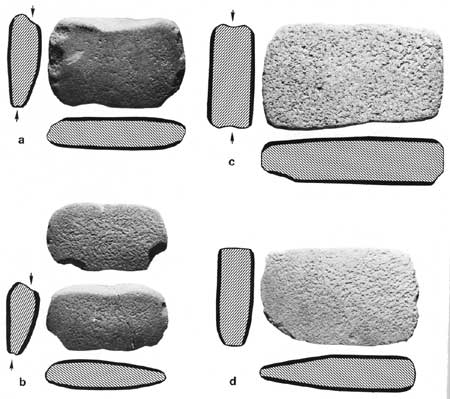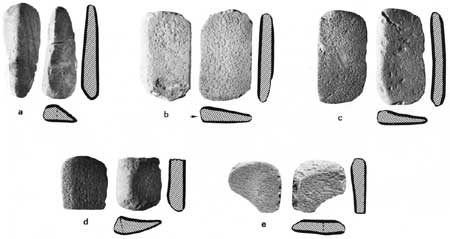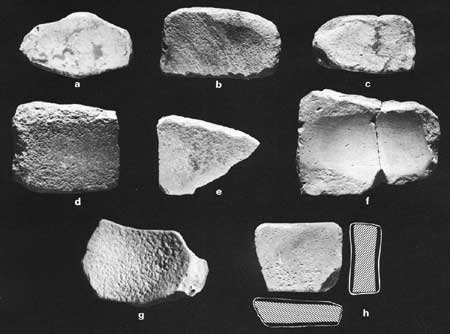|
MESA VERDE
Big Juniper House of Mesa Verde, Colorado Wetherill Mesa Studies |

|
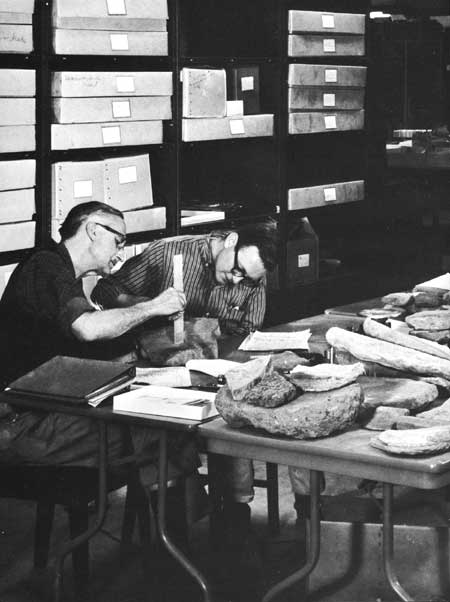
Chapter 4
stone artifacts
The stone artifacts from Big Juniper House are described under broad functional categories, such as milling or grinding and fabricating implements (table 9). The conventional classification into pecked-and-ground stone and chipped or flaked stone has not been followed here because of the many internal inconsistencies that would result. For example, a mano is a grinding implement that usually shows more than one kind of modification—flaking or spalling, to shape the tool, as well as pecking and grinding. To be sure, there are artifacts in this collection as in all collections, which cannot be identified as to function. These are described under "Objects of Uncertain Use." Other stone material, primarily chipping debris from the manufacture of stone artifacts, is considered in chapter 6.
I have identified certain artifact materials as "coarse grained igneous rock" and "fine-grained igneous rock." More precise identifications would be misleading without petrographic analysis. Almost all the raw material could have been obtained from the Mancos River gravels. Materials not available locally will be noted.
TABLE 9.—Distribution of stone artifacts by type, Big Juniper House.
(this table has been converted to PDF format).
MILLING OR GRINDING IMPLEMENTS
Stone artifacts that were clearly used for grinding or milling food and other material are described under this functional category.
Metates
A metate has been defined generally as "A stone slab on which food has been ground by means of a smaller upper stone. The grinding motion is reciprocal (back and forth) and not rotary or in varying directions" (Woodbury, 1954, p. 50).
The metates excavated at Big Juniper House are of three types: (1) troughed, open at both ends; (2) plain-faced, with a plain grinding surface and no trough or margins; and (3) plain/troughed, which does not seem to have been described previously in the literature.
Troughed metates, open at both ends. These are the most common metates at Big Juniper House (fig. 97a-e). The five complete specimens of this type were all made of local, fine- to medium-grained, brown to yellow-bluff sandstone of which the cliffs of Mesa Verde are primarily composed. Included under this type are 24 fragments. Three have both ends open, and 11 corner or end fragments have one end open and the other end missing. The remaining 10 side sections lack both ends. It is not possible to say definitely what type of metate these fragments belong to, but it is a fairly safe assumption that they came from troughed metates with both ends open. No other type of troughed metate was found at the site. (Troughed metates with one open end are characteristic of Basketmaker III, Pueblo I and early Pueblo II in the Mesa Verde area.)
Twenty-three fragments were made of the same kind of sandstone as the whole metates. The other fragment was of coarse-grained, gray-white sandstone also found locally. It is "self-sharpening," this is to say, its grinding surface did not need to be roughened to keep it an efficient milling tool. Metates usually became glassy smooth in the milling process and constantly needed "sharpening" by pecking. Almost all metates of fine- to medium-grained sandstone show evidence of sharpening.
One complete metate (fig. 97b) and two fragments had localized concave grinding surfaces on the back and may have served both as metates and "unspecialized milling stones" (described subsequently).
Generally, troughed metates are irregular to subrectangular in outline. Shaping was normally rough, bifacial spalling followed by pecking. Grinding surfaces show varying degrees of concavity and backs are frequently ground or pecked to remove irregularities. One complete metate (fig. 97a) is unusually well finished.
The borders along the grinding surface are usually well defined but some of them, reflecting either intensive use or lack of care taken in the manufacture of the metates, are very poorly defined (fig. 97e). The parts next to the grinding surface are polished, probably as the result of constant wear by the ends of the manos.
Most of the metates are made from relatively thick sandstone slabs. Two specimens, much thicker than usual, are made from blocks or boulders of sandstone (fig. 97d and e). Another is much thinner than normal (fig. 97b) and may be related to Morris' "thin-slab" type of closed-end troughed metate with a suggested ceremonial function (Morris, 1939, p. 133, pl. 149).
No troughed metates open at both ends were found in grinding position. Room 11, which seems to have been a workroom designed for corn grinding, had several slab bins without metates; however, each bin had metate supports in place.
Troughed metates with both ends open occur primarily in late Pueblo II and probably early Pueblo III. Evidence from the sites excavated by the Wetherill Mesa Project indicates that this type of metate replaced the closed-end troughed metate at least by A.D. 1000 and probably somewhat earlier.
Plain-faced metates. Three whole plain-faced metates and two fragments were found during the excavation (fig. 97f-h). They are blocky and not as well-shaped as most plain-faced metates found in later sites. Two whole metates and one fragment were made of the fine- to medium-grained sandstone. The other two specimens were made of volcanic breccia found in several dikes at Mesa Verde (fig. 97f). This material is coarse-grained and self-sharpening.
These metates are generally oval in outline. They were shaped by edge spalling or overall bifacial spalling. The grinding surface is concave excpt in one fragment, which is concave in transverse section and nearly flat in longitudinal section. Only one specimen (fig. 97g) was ground on the back. The three complete metates range in size as follows: length 32 to 41 cm.; width 23 to 24 cm.; thickness 6 to 12 cm.; and weight 7.5 to 15.8 kg.
No plain-faced metates were found in grinding position. One metate (fig. 97h) lay on the south banquette of Kiva C, and another (fig. 97f) may have been used as a deflector in Kiva A.
Plain-faced metates were probably first made in late Pueblo II or early Pueblo III, and by middle Pueblo III (around A.D. 1200) they largely replaced the troughed metates open at both ends.
Plain/troughed metates. There are three complete and three fragmentary metates of this type, all made of sandstone. Apparently, they are troughed metates, with both ends open, remodeled in the plain-faced pattern. The three complete metates show possible steps in this process. One has a well-defined border on one side of the grinding surface, with the other border spalled off (fig. 97i). Another has a poorly defined and partially ground-down border on one side, while the other border has been spalled and ground off (fig. 97j). The third metate has only a slightly raised edge along each side of the grinding surface (fig. 97k).
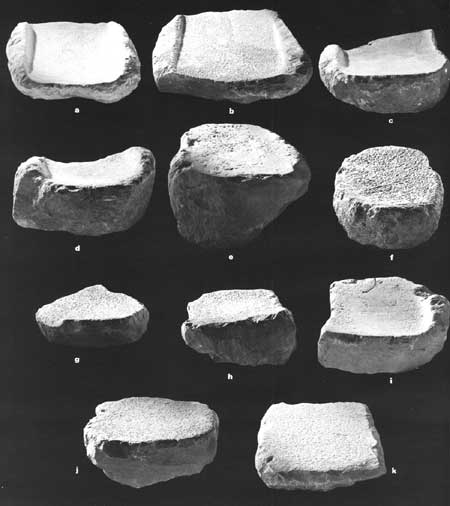
|
| Fig. 97 Metate types: troughed metates, a-e; plain-faced, f-h; and plain/troughed, i-k. Length of a is 43.2 cm. (click on image for an enlargement in a new window) |
Two of these metates are similar in shape and size to open-ended troughed metates. The other complete metate (fig. 97k) is thin and bifacially spalled and pecked around the perimeter to a rectangular outline. It may be another example of Morris' thin-slab type.
One fragment was on edge in the floor of a mealing bin (Bin 2) in Room 11 and probably served as a metate support. The other fragments and the whole specimens were found in Kiva A. The restricted distribution of this type may indicate a ceremonial function.
Manos
A mano has been defined by Woodbury (1954, p. 66) as "The tabular piece of stone held in the hands and rubbed back and forth on a metate for grinding. . . . stones used with a rotary motion are excluded."
The manos from Big Juniper House are of two types: those used on troughed metates, and a new type used both on troughed and plain-faced or plain/troughed metates. With one possible exception (fig. 98a), there were no manos used exclusively on plain-faced metates.
These tools generally show more care in manufacture than do the metates. Shaping was done by spalling and pecking and a few were ground on the sides and ends and sometimes on the backs.
Some of the manos from Big Juniper House could have been manipulated best with two hands and many more could have been used more efficiently with one hand, but I found no consistent length groupings, coupled with other observable features, to justify setting up "two-handed" and "one-handed" varieties. (The "hand-stones," described later, were undoubtedly used with one hand only.)
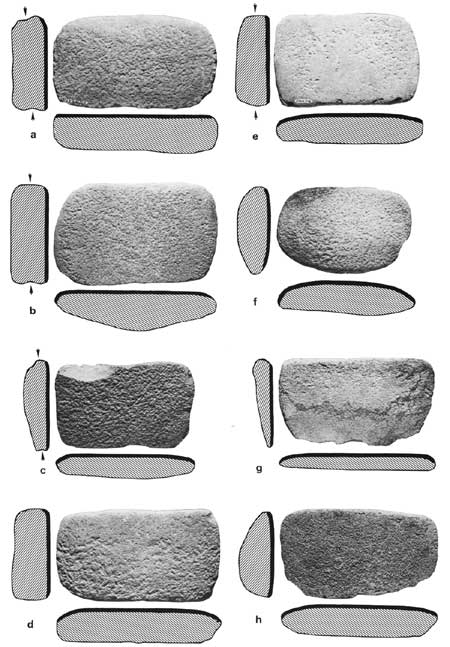
|
| Fig. 98 Subtype 1A manos. Arrows indicate location of finger-grips, heavy lines on sections represent grinding surface. Length of a is 21.5 cm. (click on image for an enlargement in a new window) |
Type 1—Unifacial or bifacial, with grinding surface convex from end to end. Ends are usually beveled or canted from the grinding surface as a result of wear on the borders of troughed metates, which show complementary wear. Four subtypes are recognized.
Subtype 1A manos are unifacial, with the single grinding surface convex from end to end and flat to slightly convex from side to side (fig. 98).
Forty-three whole and 36 fragmentary manos were classified as Subtype 1A. Eight whole manos had finger-grips, or small depressions pecked on each side and approximately opposite each other, and four fragments had one or two finger-grips extant (fig. 98a-c). There were never more than two finger-grips, and they were always paired. Finger-grips were more likely to occur on the thicker manos.
All but five manos of this subtype were made of fine-grained sandstone, including five river cobbles. The other five manos were made from granular igneous rock (2), conglomerate (1), coarse-grained sandstone (1), and quartzite (1), and all of these are considered to be self-sharpening.
Subtype 1A manos are subrectangular, suboval, or subtriangular in outline. Cross sections are generally tabular or rectangular, and a few are wedge-shaped and "humpback." The humpbacks are usually not loaf-shaped—the shape typical of many late Pueblo III manos used on plain-faced metates. Almost all the manos of fine-grained sandstone were sharpened by pecking in order to make them effective grinding tools.
The following are dimensions and weights of Subtype 1A manos:
| Length (cm.) |
Width (cm.) |
Thickness (cm.) |
Weight (kg.) | |
| Maximum | 23.8 | 13.9 | 5.9 | 2.6 |
| Minimum | 17.6 | 8.5 | 1.6 | .6 |
| Average | 20.8 | 11.7 | 3.2 | 1.3 |
Subtype 1B manos are unifacial, with two adjacent grinding surfaces convex from end to end and more or less flat from side to side (fig. 99). The line between the grinding surfaces is either parallel or oblique to the long axis of the mano; it is sometimes very poorly defined (fig. 99f).
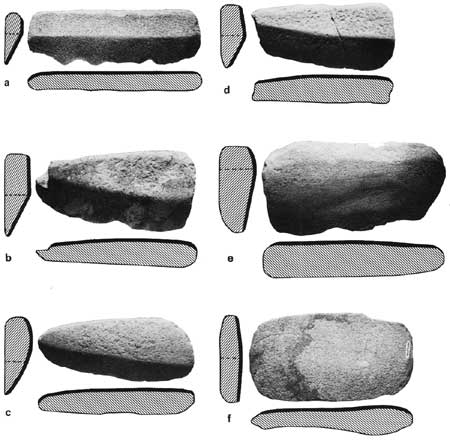
|
| Fig. 99 Subtype 1B manos. Dashed line indicated juncture of two grinding surfaces. Length of a is 24.2 cm. (click on image for an enlargement in a new window) |
There were 12 whole and 25 fragmentary specimens. One complete mano has a single finger-grip and another has a finger-grip on each side. One fragment has a finger-grip on one side.
One mano fragment of volcanic breccia was self-sharpening. The rest of the fragmentary and whole manos were made of the same kind of sandstone used for the majority of Subtype 1A manos. Almost all Subtype 1B manos were sharpened by pecking. One of the grinding surfaces was often worn more than the other.
Subtype 1B manos range in outline from subrectangular to suboval to subtriangular. Cross sections are usually rectangular to oblong in longitudinal section and triangular or rounded in transverse section. Subtype 1B manos are generally much thinner than those of Subtype 1A.
The following are dimensions and weights of Subtype 1B manos:
| Length (cm.) |
Width (cm.) |
Thickness (cm.) |
Weight (kg.) | |
| Maximum | 24.7 | 12.9 | 4.5 | 1.7 |
| Minimum | 15.7 | 7.5 | 1.4 | .4 |
| Average | 20 4 | 10.3 | 2.6 | .8 |
Subtype 1C manos are bifacial, with the single grinding surface on each face convex from end to end and more or less flat from side to side (fig. 100). They are rectangular or, less commonly, suboval in outline. Longitudinal sections are primarily subrectangular and slightly biconvex, while the transverse sections are subrectangular or wedge-shaped.
Of the 11 whole and 17 fragmentary manos of Subtype 1C, 9 whole specimens and 11 fragments were fine-grained sandstone. One whole mano and one fragment were made of quartzite, and one whole mano was made from a coarse-grained igneous rock (fig. 100c). Two fragments were made of volcanic breccia and self-sharpening sandstone.
Four whole manos and one fragment had finger-grips. One of the four complete specimens had three finger-grips, two on one side and one on the opposite side (fig. 100a). The fragment had a single finger-grip on the thicker side. Most Subtype 1C manos had been sharpened by pecking.
The following are dimensions and weights of Subtype 1C manos:
| Length (cm.) |
Width (cm.) |
Thickness (cm.) |
Weight (kg.) | |
| Maximum | 23.5 | 13.5 | 5.0 | 2.7 |
| Minimum | 11.4 | 8.9 | 2.4 | .9 |
| Average | 20.1 | 11.4 | 3.5 | 1.2 |
Subtype 1D is represented by one bifacial mano with two grinding surfaces on one face and one grinding surface on the opposite face (fig. 101a). It is convex in longitudinal section and flat to slightly convex in transverse section. The ends are markedly and slightly beveled or canted from the face with the single grinding surface but not from the other face.
Made of fine-grained sandstone, this mano is subtriangular in outline. Two of the grinding surfaces are worn fairly smooth and the third has been sharpened by pecking. A pecked area on part of the thicker side may have served as a finger-grip. Measurements are: length 21.8 cm., width 8.5 cm., maximum thickness 3.5 cm., and weight 0.6 kg.
Type 2—Bifacial, with grinding surfaces which are convex or concave from end to end. Two subtypes are recognized.
Subtype 2A manos have two grinding surfaces, each; one of these is convex from end to end, and the other is concave from end to end (fig. 101b and e). The four manos of this subtype may have started as unifacial manos used on troughed metates, and were later turned over and used on plain-faced or plain/troughed metates. There is reason to believe that the three metate types were used simultaneously during the latter part of the occupation of Big Juniper House. It follows that all the mano types were used simultaneously during this time.
Three of the manos were made of the sandstone apparently preferred in the majority of manos and metates. The fourth was made of the self-sharpening variety of sandstone (fig. 101c). One mano had a single finger-grip (fig. 101b) on the thicker side, and may have had one on the other side before it was worn thin.
One grinding surface is convex longitudinally and flat to convex transversely; ends are beveled or canted from use on troughed metates. The opposite grinding surface is concave longitudinally and flat to slightly concave to slightly convex, from use on plain-faced or plain/troughed metates; ends are not beveled or canted. All grinding surfaces show sharpening by pecking. The ranges of dimensions and weights of Subtype 2A manos are: length 16.3-22.2 cm.; width 8.8-12.0 cm.; thickness 2.4-3.3 cm.; and weight 0.6-1.1 kg.
Subtype 2B manos, represented by two fragments, had three grinding surfaces, two on one face and one on the opposite face (fig. 101d and e). The two grinding surfaces on one face are convex from end to end and flat to slightly convex from side to side, from use on troughed metates. The single grinding surface on the opposite face is concave longitudinally and slightly concave transversely, from use on a plain-faced or plain/troughed metates.
Both specimens are made of the common fine-grained sandstone. They had been sharpened by pecking, and they lacked finger-grips. Measurements are: 12.8 and 12.0 cm. wide and 2.4 and 3.5 cm. thick, respectively.
Two manos of this subtype were found at Badger House and a number of Type 2 manos were excavated by the Awatovi Expedition at Antelope Mesa sites in north eastern Arizona (Woodbury, 1954, p. 68). Some of these manos have one flat grinding surface opposite the convex one, but they were found in contexts earlier than flat metates (classified as plain-faced metates here). Woodbury suggests that these manos were used on grinding slabs, or that they were ground on one face, either to provide an area to be used as a whetstone or to improve their appearance. However, he believes that manos with two flat grinding surfaces opposite the convex one were used first on troughed metates and then on flat metates.
Mortars
Two stone artifacts, with one circular, pecked and ground depression, each, were classified as mortars. One of these (fig. 102, left), a possible sandstone concretion, measures 10.1 by 9.8 by 3.1 cm., and weighs 5 kg. The depression is 6.5 cm. in diameter and 0.9 cm. deep. The other mortar (fig. 102, right). is a sandstone block measuring 21 by 16.8 by 8.7 cm., and weighing 4.2 kg. The depression is 7.5 cm. in diameter and 1.1 cm. in depth.

|
| Fig. 102 Mortars. Mortar at left is 10.7 cm. in maximum diameter; one at right is 21 cm. in length. |
Unspecialized Milling Stones
Twenty-two grinding tools from Big Juniper House that were obviously used as netherstones are designated as "unspecialized milling stones." Their function was not necessarily restricted to food preparation, as metates are thought to have been, and, unlike metates and mortars, their shapes are purely fortuitous. Suggested functions for these artifacts, aside from possible use in grinding food, are preparation of pigment and grinding rocks or sherds for pottery temper. Four types are recognized on the basis of their grinding surfaces.
Type 1—Unifacial or bifacial, with concave grinding surface. Of the 14 specimens of this type, 11 complete and 2 fragmentary examples are unifacial and one complete specimen is bifacial (fig. 103h). Twelve are made of the common sandstone; half of these were sharpened by pecking, and the others were worn smooth. The remaining two specimens were made of self-sharpening, coarse-grained igneous rock (fig. 103d) and volcanic breccia.
These milling stones are subrectangular or suboval in outline. They could be held in the lap or, in the case of several of the smaller ones, in one hand of the person doing the grinding.
The single bifacial milling stone has a red paint stain on one grinding surface, and a fragmentary specimen, the modified side fragment of a plain/troughed metate, also has a paint stain on the grinding surface (fig. 103e).
One Type 1 specimen has a deep concave grinding surface and may have been a "basin metate"—a type of milling stone that is rarely found in the Mesa Verde area (fig. 103g)
One complete troughed metate and two troughed metate fragments had small concave grinding surfaces on the face opposite the grinding surface.
The following are dimensions and weights of Type 1 unspecialized milling stones:
| Length (cm.) |
Width (cm.) |
Thickness (cm.) |
Weight (kg.) | |
| Maximum | 28.3 | 20.4 | 9.0 | 20.2 |
| Minimum | 14.2 | 11.0 | 2.2 | .7 |
| Average | 22.1 | 14.1 | 4.9 | 6.3 |
Type 2—Re-used manos, with concave grinding surface. The two specimens, both complete, were originally Subtype 1A manos (fig. 104a and b). Both were made of the common sandstone and were sharpened by pecking. They could have been held in the lap or in one hand during use.
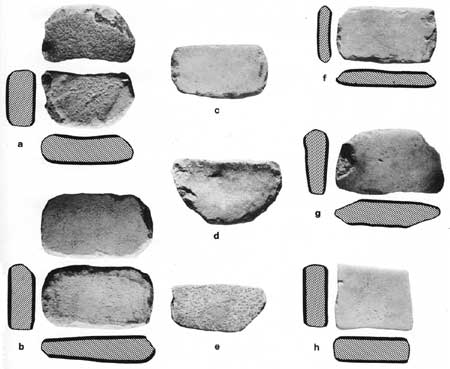
|
| Fig. 104 Unspecialized milling stones. Type 2, a, b; Type 3, c-e; Type 4, f-h. Length of a is 18.7 cm; length of g, not to scale, is 21.5 cm. (click on image for an enlargement in a new window) |
Type 3—Unifacial, with flat grinding surface. The three complete examples were made of the common sandstone (fig. 104c-e). Two are subrectangular and one is semicircular in outline. They were worn smooth or fairly smooth with use. One of the rectangular specimens was carefully ground on the sides, ends, and back (fig. 104c). The other rectangular milling stone had a red paint stain on the grinding surface (fig. 104e).
Type 4—Bifacial, with flat and concave grinding surfaces. The three specimens, subrectangular in outline, were made of the common sandstone (fig. 104f-h). One is ground on all edges and faces (fig. 104h), and another is bifacially spalled and ground on the perimeter (fig. 104f).
Handstones
Eight oval grinding implements were classified as hand-stones (fig. 105). It is assumed that they were used primarily with unspecialized milling stones. However, the discovery of a handstone in association with a troughed metate at Two Raven House on Wetherill Mesa suggests that handstones were used, at least part of the time, with metates.

|
| Fig. 105 Handstones. Cobble handstones, a-e. Length of a is 12.8 cm. Braccia handstone, f, is 13.9 cm. in length. |
Seven of the handstones are complete and one is fragmentary. Six of them are quartzitic sandstone; one is of a sandstone which is much harder than that of most metates and manos; and one is a very coarse-grained igneous breccia (fig. 105f). The sandstone specimens are stream cobbles showing little modification. The breccia handstone is from quarried material and has been shaped by spalling.
Since grinding striations on the handstones are usually not alined in one direction, it seems likely that most of these tools were used with a rotary motion. None of the handstones show much wear and most of them show secondary use as hammerstones, with the perimeter lightly battered and pecked. One specimen has a possible finger-grip in the middle of each side (fig. 105e). Two hand stones are unifacial, the other six are bifacial. There is only one grinding surface on a face. Their sizes suggest they were used with one hand.
The following are dimensions and weights of handstones:
| Length (cm.) |
Width (cm.) |
Thickness (cm.) |
Weight (kg.) | |
| Maximum | 13.9 | 10.3 | 6.2 | 0.85 |
| Minimum | 10.2 | 7.7 | 2.2 | .54 |
| Average | 11.5 | 8.8 | 4.1 | .63 |
Crushers
Nine subrectangular grinding tools—eight complete and one fragmentary—are distinguishable from manos and handstones by their greater massiveness (fig. 106). They have been tentatively designated as "crushers" on the assumption that they were used to pulverize hard materials for tempering.
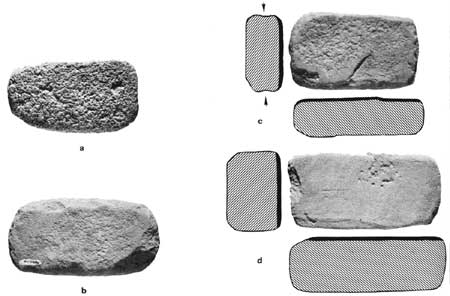
|
| Fig. 106 Crushers. Length of a is 23 cm. (click on image for an enlargement in a new window) |
Seven specimens are of hard-grained sandstone, one of quartzite, and one of sedimentary conglomerate (fig. 106a). They were shaped by spalling and pecking. One is bifacial and the rest are unifacial. The grinding surfaces vary from slightly convex to flat, and most of them show evidence of sharpening by pecking. One complete crusher (fig. 106c) has one finger-grip on each side. The bifacial crusher has a finger-grip on one side. None of them show the characteristic wear facet at the ends of the grinding surface typical of manos used on troughed metates.
The following are dimensions and weights of crushers:
| Length (cm.) |
Width (cm.) |
Thickness (cm.) |
Weight (kg.) | |
| Maximum | 25.6 | 14.2 | 7.6 | 4.5 |
| Minimum | 18.5 | 11.2 | 4.7 | 2.4 |
| Average | 22.7 | 12.9 | 6.4 | 3.3 |
| <<< Previous | <<< Contents>>> | Next >>> |
archeology/7c/chap4.htm
Last Updated: 16-Jan-2007
